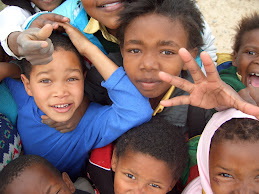Sunday, September 03, 2006
Describing South Africa
It’s difficult to describe this place. There are contrasts all around me. I am staying in a house in an upper middle class neighborhood here, and I travel 30 minutes to the town, Delft, where the HIV home-based healthcare program is. It’s not safe for me to take a taxi to Delft alone. But there are not bars on all the houses' windows (only some of them) like in Honduras. On the way I pass by shanty towns made of tin and cows feeding on grass in the median of the highway. At the same time, it seems like this place is very similar to the U.S. Nice roads, nice neighborhoods, traffic laws that are obeyed. There is the occassional horse drawn cart on the highway though. There are three race classifications here: black, colored, and white. The word colored sounds so ugly to the American ear at first, almost hurting to say it. It has been a bad word in our culture for so long, that it feels weird that these people here should claim that label with pride. The colored people are exactly as the word sounds—colored. They are people of color that are not black, so this includes all kinds of mixtures that can include blacks, whites, Indians, and Asians. The government is full of contrasts… putting up a front of being forward thinkers, yet the highest government officials do not believe that HIV causes AIDS. The prime minister of health says that “nutrition, nutrition, nutrition,” is the answer. The vice president raped a girl who was HIV + (but he was acquitted, so I guess I should say he had consensual sex). He did not use a condom, but claimed that it was okay, because he took a shower afterwards and washed off real well. A South African female is raped every 3 minutes. One-year-old baby girls are not safe from this atrocity. You see there is a myth poisoning the minds of desperate and depraved HIV+ men that if they rape a virgin, then they will be cured of HIV/AIDS. The younger the girl, the more sure you can be that she is a virgin. Many rape victims are between the ages of 1 to 5. ARV drugs are available for those with AIDS, but distributing the drugs is problematic, and many do not even get tested for HIV because they fear being ostracized by friends and family. Another mother is HIV+ but she still wants to have more children—children that will grow up without a mother. Hospitals are good here—for the rich. They tell the women in the general public to get a PAP smear once every 10 yrs! It’s not that doctors are ignorant to the benefits of yearly PAP smears, but that the government needed to make budget cuts, and so they made them with women’s lives. Once every 10 yrs is a joke. You can very easily get cervical cancer and die during the 9 years in between. There’s this beautiful ocean here and nice skyline and then there is the wasteland of tin shacks that sits on the outskirts of town. Out of sight. I haven’t gotten to do much in the way of direct patient care yet, but I have gotten to see a lot, listen to a lot, and learn a lot. I love these people. They are so nice. I have a million ideas racing through my head, and I don’t know where to begin. I feel so helpless. How can I ever make a difference? Things are so screwed up. How will they ever get better? How can I wait 3 more years to come back here? It seems weird that there are so many problems in this country because there is so much potential here, and because at times I feel like it is not a developing country at all. It’s definitely not the place with the starving children on the TV screen with the flies swarming around their faces. I’m sure there is a lot of malnutrition and starvation at times too, but not like other parts of Africa. Yet, they have a real crisis on their hands: AIDS. This slow killer. Not only will it kill individuals, but it has the power to bring down a whole nation if nothing is done.
Subscribe to:
Post Comments (Atom)

1 comment:
I don't think you're gonna get any comments here. We're all trying hard to swallow this description of utter denial and irresponsibility.
Post a Comment